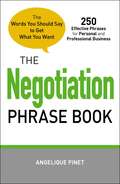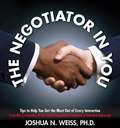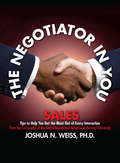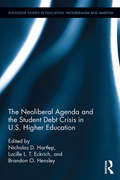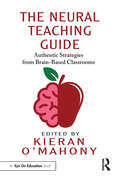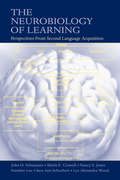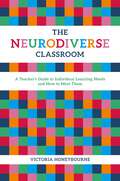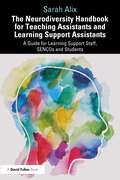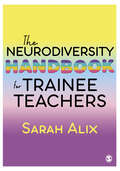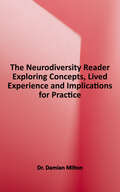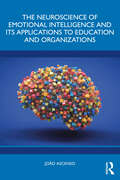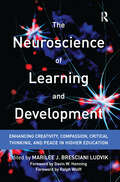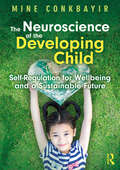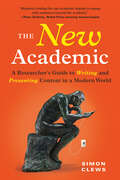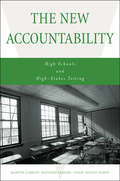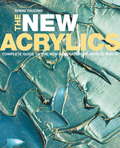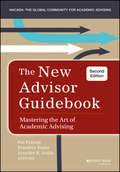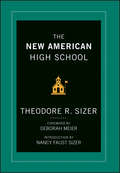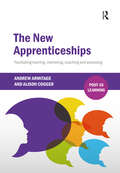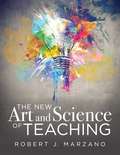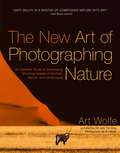- Table View
- List View
The Negotiation Phrase Book: The Words You Should Say to Get What You Want
by Angelique PinetDo you want to clinch a sale? Get a better salary? Make a terrific deal on a new house?Then get ready to negotiate!Your life is all about bargaining--everything from setting a price with a vendor at work to talking to your teenager at home about an allowance. Experienced negotiators have a huge advantage in these discussions, because they know what words and phrases work. And you can join their ranks.Here's your essential guide to what to say at each stage of the negotiation. You'll learn how to:Evaluate the needs of your negotiating partnerDecide what the other party's words really meanStructure offers and counteroffersDetermine your minimum walkaway pointThe best words will get you the best deal. So get in there and start bargaining!
The Negotiator in You: Negotiation Tips to Help You Get the Most out of Every Interaction at Home, Work, and in Life
by Joshua N. WeissThe Negotiator in You is an introduction to negotiation specifically for people who don't tend to view themselves as negotiators. In this eBook original, Joshua N. Weiss, Ph.D. co-founder of the Global Negotiation Initiative at Harvard University, gives us the tools to enter into a myriad of negotiations with confidence. For workplace negotiations, Weiss coaches us how to effectively negotiate externally with our customers and internally with our boss, colleagues, and subordinates. In a downturned economy, Weiss pays special attention to salary negotiations and finding value among many other factors currently facing everyone in organizations. Beyond the workplace, there are two other critical areas where we negotiate frequently--at home and in life. Turning his eye inward on how we interact at home, Weiss gives us headache-saving tips on how to navigate our way through the holidays and in everyday interactions with our loved ones. And in the negotiations we find ourselves in with the world around us--whether buying a car or house or negotiating with credit card companies--this is essential reading so you don't get taken advantage of. With personalized worksheets for each section you can turn to time and again, the Negotiator in You is the primer you need for smooth sailing at work, home and in life in general.
The Negotiator in You: Sales
by Joshua N. WeissThe Negotiator in You: Sales is for people who sell anything and everything! Salespeople negotiate constantly in today's increasingly competitive marketplace--making negotiation one of the most vital skills. In this book, you will learn to overcome the following key challenges: the tension between short-term gratification (making the sale) and nurturing long-term customers (building the relationship), the problem of negotiating with oneself and how to prevent that from happening, when to take lessons from one negotiation and transfer them and when not to, mapping the players and getting internal alignment before engaging externally, ensuring that an agreement makes sense for you and your company, finding hidden value, dealing with difficult customers--while still making the sale, and using some "crazy wisdom" to engage your customers.
The Neoliberal Agenda and the Student Debt Crisis in U.S. Higher Education: Indebted Collegians of the Neoliberal American University (Routledge Studies in Education, Neoliberalism, and Marxism)
by Nicholas D. Hartlep Brandon O. Hensley Lucille L.T. EckrichCapturing the voices of Americans living with student debt in the United States, this collection critiques the neoliberal interest-driven, debt-based system of U.S. higher education and offers alternatives to neoliberal capitalism and the corporatized university. Grounded in an understanding of the historical and political economic context, this book offers auto-ethnographic experiences of living in debt, and analyzes alternatives to the current system. Chapter authors address real questions such as, Do collegians overestimate the economic value of going to college? and How does the monetary system that student loans are part of operate? Pinpointing how developments in the political economy are accountable for students’ university experiences, this book provides an authoritative contribution to research in the fields of educational foundations and higher education policy and finance.
The Neural Teaching Guide: Authentic Strategies from Brain-Based Classrooms
by Kieran O’MahonyThe Neural Teaching Guide showcases the innovative practices of K-12 teachers who are effectively applying findings from educational neuroscience into their classrooms. Educators today have remarkable opportunities to understand how the complex and often malleable functions of the brain affect learning, behavior, and social-emotional dynamics, but what practical strategies come out of this information? Authored by in-service teachers around the country, this book showcases a variety of brain-based approaches – cutting-edge yet intuitive, evidence-based yet accessibly translated – to helping children realize their potential at school. Both novice and veteran K-12 teachers alike will be reinvigorated to enhance students’ engagement and curiosity, nurture positive behaviors and self-regulation, support interest-based activities and inclusive interactions, identify biases and struggles, and more.
The Neurobiology of Learning: Perspectives From Second Language Acquisition (Language Learning Monograph Ser.)
by John H. Schumann Sheila E. Crowell Nancy E. Jones Namhee Lee Sara Ann SchuchertThis book constitutes a timely contribution to the existing literature by presenting a relatively comprehensive, neurobiological account of certain aspects of second language acquisition. It represents the collaborative efforts of members of the Neurobiology of Language Research Group in the Applied Linguistics and TESL Department at UCLA. Members of the group are trained in neurobiology and then use this knowledge to develop biological accounts of various aspects of applied linguistics.The volume avoids the corticocentric bias that characterizes many brain-language publications--both cortical and subcortical structures receive their appropriate attention. In addition, it demonstrates that enough is presently known about the brain to inform our conceptualizations of how humans acquire second languages, thus, it provides a refreshingly novel, highly integrative contribution to the (second) language acquisition literature.The goal of the research program was based on the need to draw more links between the neurobiological mechanisms and second language acquisition. As such, the book promotes a neurobiology of language that starts with the brain and moves to behavior. The fundamental insights presented should guide second language acquisition researchers for years to come.
The Neurodiverse Classroom: A Teacher's Guide to Individual Learning Needs and How to Meet Them
by Victoria HoneybourneWith specific learning difficulties more prevalent than ever in mainstream schools, this is the essential guide for teachers wishing to create inclusive and successful learning environments in diverse classrooms. Focusing on promoting acceptance and self-esteem of each child rather than on labelling their difficulties, it shows how to make good use of simple resources and meet a wide range of needs, including children with ADHD, autism, OCD, dyslexia and special speech and language needs. The practical advice and strategies in this book enable schools to become more accepting places for all pupils, and embrace neurodiversity as the new 'normal' in education today.
The Neurodiversity Handbook for Teaching Assistants and Learning Support Assistants: A Guide for Learning Support Staff, SENCOs and Students
by Sarah AlixThis highly practical book supports the knowledge and development of teaching assistants and learning support assistants (TAs/LSAs) in their understanding of neurodivergent pupils. Considering a neurodivergent world is vital in society today, and even more so in the classroom. Starting with a model of difference rather than deficit and highlighting the complexities involved, this accessible resource focuses on effective strategies to support these pupils and explores the vital role of learning support in a range of different contexts. Rich in pedagogical features, this book includes chapter objectives, areas for the reader to reflect upon, links throughout to the Teaching Assistant Standards and case studies for the reader to examine. Each chapter also has a further reading section which will include links to articles, websites, and organisations that can aid and support the development of TAs and LSAs. This important work will provide Special Educational Needs Co-ordinators (SENCos) with a framework to support their support staff in the classroom.
The Neurodiversity Handbook for Trainee Teachers
by Sarah AlixConsidering a neurodivergent world is vital in society today, and even more so in the classroom. This book will support your knowledge and development as a trainee teacher so you can better understand the complexities of working with neurodivergent pupils. Starting with a model of difference rather than deficit, this book will guide trainee teachers to understand neurodiversity within the classroom, providing strategies which aim to support their students. Dr Sarah Alix is Initial Teacher Training Programme Director with the Sigma Trust
The Neurodiversity Handbook for Trainee Teachers
by Sarah AlixConsidering a neurodivergent world is vital in society today, and even more so in the classroom. This book will support your knowledge and development as a trainee teacher so you can better understand the complexities of working with neurodivergent pupils. Starting with a model of difference rather than deficit, this book will guide trainee teachers to understand neurodiversity within the classroom, providing strategies which aim to support their students. Dr Sarah Alix is Initial Teacher Training Programme Director with the Sigma Trust
The Neurodiversity Reader: Exploring Concepts, Lived Experience and Implications for Practice
by Damian MiltonThis thought-provoking collection is written for all stakeholders with autism and neurodivergent conditions. Despite having wide impact on a variety of disciplines, neurodiversity and related concepts are often poorly understood, which can lead to uninformed debate and potential tensions between stakeholders regarding service provision for those with neuro-developmental disabilities. The Neurodiveristy Reader brings together work from pioneering figures within and beyond the neurodiversity movement to critically explore its history, the concepts of neurodiversity that have shaped it, lived experiences, and how a better informed understanding might be translated into practice and service provision. Through a variety of accounts, the relevance and criticisms of these concepts in understanding ourselves and one another are examined, as well as important implications for practice. A primary text for support professionals and students of neurodivergent experiences and disability, as well as neurodivergent people themselves.
The Neuropsychologist's Workbook: A Hands-On Roadmap to Training and Developing Your Career
by Cady Block Sabrina Hickle PhDUnlock your career in neuropsychology with this practical workbook for aspiring professionals. This is a hands-on, practical workbook to accompany The Neuropsychologist&’s Roadmap: A Training and Career Guide. This workbook covers the training journey in neuropsychology, as well as its foundational and functional competencies. The workbook allows readers to access additional information, benefit from even more advice, and engage interactively with activities such as self-assessments, checklists, free writing exercises, and more. These activities help the reader reflect on and articulate personal values and goals to help guide them through their own journey. Using this workbook will help readers recognize their own strengths and weaknesses, so they know what they need to work on when considering the factors impacting entry into (and success within) graduate school, internship, fellowship, and the first job. This is a valuable resource for anyone considering a career in neuropsychology or those who train, supervisor, or mentor students in this field.
The Neuroscience of Emotional Intelligence and Its Applications to Education and Organizations
by João AscensoThis book provides a clear understanding of the neuromechanisms of emotional intelligence and its applications to education and organizations through practical exercises.Divided into three parts, the book begins by explaining the data that help us understand the neural mechanisms of emotional intelligence. Part 2 focuses on application in educational contexts by presenting emotional intelligence education programs for children and adolescents as well as an analysis of emotional intelligence from a practical point of view. Part 3 switches the focus to organizations through the leadership with emotional and social intelligence model as proposed and validated by Daniel Goleman and Richard Boyatzis. Both parts offer a series of practical and engaging exercises for application to adolescents, children and educators, and organizational environments respectively. Presented simply, the book gives a scientifically rigorous and structured overview of how neuroscience has helped in understanding the neural mechanisms of emotions and its applications.It is indispensable reading for neuroscientists, psychologists, leaders, managers, teachers, and educators, and all those interested in the search for personal and professional success.
The Neuroscience of Learning and Development: Enhancing Creativity, Compassion, Critical Thinking, and Peace in Higher Education (An\acpa / Naspa Joint Publication)
by Gavin W. Henning Ralph Wolff Marilee J. Bresciani LudvikIs higher education preparing our students for a world that is increasingly complex and volatile, and in which they will have to contend with uncertainty and ambiguity? Are we addressing the concerns of employers who complain that graduates do not possess the creative, critical thinking, and communication skills needed in the workplace? This book harnesses what we have learned from innovations in teaching, from neuroscience, experiential learning, and studies on mindfulness and personal development to transform how we deliver and create new knowledge, and indeed transform our students, developing their capacities for adaptive boundary spanning.Starting from the premise that our current linear, course-based, educational practices are frequently at odds with how our neurological system facilitates learning and personal development, the authors set out an alternative model that emphasizes a holistic approach to education that integrates mindful inquiry practice with self-authorship and the regulation of emotion as the cornerstones of learning, while demonstrating how these align with the latest discoveries in neuroscience. The book closes by offering practical ideas for implementation, showing how simple refinements in classroom and out-of-classroom experiences can create foundations for students to develop key skills that will enhance adaptive problem solving, creativity, overall wellbeing, innovation, resilience, compassion, and ultimately world peace.Co-published with ACPA – College Student Educators International
The Neuroscience of the Developing Child: Self-Regulation for Wellbeing and a Sustainable Future
by Mine ConkbayirThe Neuroscience of the Developing Child informs Early Years (EY) students, practitioners and parents about the fundamental importance of self-regulation (SR) as a critical skill for young children to develop if they are to go on to lead happy and fulfilled lives. Packed with accessible information concerning the neuroscience of early brain development alongside real-life case studies, this book clearly demonstrates how to put SR theory into action across educational and home settings. Dr Conkbayir draws upon a wide range of resources to show readers how they can nurture SR through their daily interactions with children and the environment and experiences they offer them. Comprehensive and engaging chapters cover topics such as: Examining what exactly SR is (and what it is not) Co-regulation’s critical role in enabling SR to occur Exploring the developing brain The importance of sensory integration as part of SR Using relational approaches to nurture behaviour in the classroom and at home The wider global role of SR in creating a sustainable future. With real-life case studies and reflective questions in every chapter, this book is essential reading for students and practitioners within the EY sector, as well as anyone beyond the sector wanting to develop their understanding of SR and how to apply it for themselves and others.
The Neurotic Parent's Guide to College Admissions
by J. D. RothmanAdmissions rates of 6 percent? Kids applying to thirty-two colleges? Sixteen-year-olds with more impressive resumes than Fortune 500 CEOs? Has the nation lost its mind? Why yes, it has! J.D. Rothman, the Neurotic Parent of blog fame, takes readers on a hilarious satiric journey through today's insane college admissions process. The vividly illustrated book takes you from the Itsy-Bitsy Fiske Guide and Junior Kumon Tips for Preschoolers through Rejection Letters from the Heart and Bed Bath & Bye-Bye.
The New Academic: A Researcher's Guide to Writing and Presenting Content in a Modern World
by Simon ClewsWhat does it mean to be an academic in today's rapidly changing world?As a modern academic, you're expected to wear many hats. It's not enough to be outstanding in your chosen field. You also need to be able to connect with audiences, speak with wit and flair, write knock-out articles, attract media attention, and share it all with your huge social media following. But how do you do all of that?In The New Academic, Simon Clews offers a wealth of practical advice on how to write and speak in an entertaining, informative, and—above all else—accessible way. Aimed at researchers at all levels of experience, this book will set you up with the basics of writing and speaking for wide audiences, then teach you how to develop a public profile and gain traction online. In a rapidly changing world, The New Academic shows scholars how to be front and center in the public conversation, allowing more people to benefit from their knowledge and research.Funny, lively, and insightful, this is your hands-on guide for sharing your research with the world.
The New Accountability: High Schools and High-Stakes Testing
by Martin Carnoy Richard Elmore Leslie Santee Siskin"Standard-based accountability" has become a consistent buzzword emanating from the mouths of hopeful politicians-liberal and conservative-for almost twenty years. But does accountability work? The New Accountability explores the current wave of assessment-based school accountability reforms, which combine two traditions in American education-public accountability and student testing.
The New Acrylics
by Rheni TauchidThe acrylics of today have grown into the most adaptable art material of the modern age. Focusing on a popular art medium that has been around for over 50 years, The New Acrylics illustrates how artists can create lush textures, color, and luster with the modern acrylics readily available in any art supply store. These are nontoxic, environmentally sound, and exist in the most dazzling array of chemical formats--from the most fluid to the highly viscous. Not only do artists paint with acrylics these days, they can create rich metallic effects, or even 3-dimensional sculptures. Traditional technique based books on acrylics cover traditional methods of painting. However, The New Acrylics is geared toward more nonconventional ways in which to manipulate modern-day acrylics, and demonstrates new applications such as glazing, textured effects, soft sculpture effects, or staining, thus reinventing the old way of handling acrylics, and revealing a fabulous new artistic medium. The underlying theme of this dazzling and sophisticated book is to encourage artists to interpret and handle acrylic paints in a vibrant, fresh, and above all, individualistic style.
The New Advisor Guidebook: Mastering the Art of Academic Advising
by Jennifer E. Joslin Pat Folsom Franklin YoderThis is an exciting time to be an academic advisor—a time in which global recognition of the importance of advising is growing, research affirms the critical role advising plays in student success, and institutions of higher education increasingly view advising as integral to their missions and essential for improving the quality of students' educational experiences. It is essential that advisors provide knowledgeable, realistic counsel to the students in their charge. The New Advisor Guidebook helps advisors meet this challenge. The first and final chapters of the book identify the knowledge and skills advisors must master. These chapters present frameworks for setting and benchmarking self-development goals and for creating self-development plans. Each of the chapters in between focuses on foundational content: the basic terms, concepts, information, and skills advisors must learn in their first year and upon which they will build over the lengths of their careers. These chapters include strategies, questions, guidelines, examples, and case studies that give advisors the tools to apply this content in their work with students, from demonstrations of how student development theories might play out in advising sessions to questions advisors can ask to become aware of their biases and avoid making assumptions about students to a checklist for improving listening, interviewing, and referral skills. The book covers various ways in which advising is delivered: one-to-one, in groups, and online. The New Advisor Guidebook serves as an introduction to what advisors must know to do their jobs effectively. It pairs with Academic Advising Approaches: Strategies That Teach Students to Make the Most of College, also from NACADA, which presents the delivery strategies successful advisors can use to help students make the most of their college experience.
The New American College Town: Designing Effective Campus and Community Partnerships
by James Martin; James E. SamelsA new perspective on the relationships among colleges, universities, and the communities with which they are now partnering.Colleges and universities have always had interesting relationships with their external communities, whether they are cities, towns, or something in between. In many cases, they are the main economic driver for their regions—State College, Pennsylvania, or Raleigh, North Carolina, for example—and in others, they exist side by side with thriving industries. In The New American College Town, James Martin, James E. Samels & Associates provide a practical guide for planning a new kind of American college town—one that moves beyond the nostalgia-tinged stereotype to achieve collaborative objectives.What exactly is a college town in America today? Examining the broad range of partnerships transforming campuses and the communities around them, the book opens by detailing twenty characteristics of new American college towns. Subsequent chapters invite presidents, provosts, planners, mayors, architects, and association directors to share their views on how college town relationships are shaping new generations of students and citizens. The book tackles urban and rural institutions, as well as community colleges, and closes with predictions about what college towns will look like in twenty-five years. Contributors include presidents from Lehigh, Portland State, New Jersey City, and Connecticut College, along with five college town mayors and the current or former executive directors from the International Town-Gown Association, the Association for the Study of Higher Education, and others.The book also traces how town-gown relations are expanding into innovative areas nationally and internationally, moving beyond familiar student life programs and services to hundred-million-dollar downtown developments. The first comprehensive, single-volume resource designed for leaders on both sides of these conversations, The New American College Town includes action plans, lessons learned, and pitfalls to avoid in developing transformative relationships between colleges and their extended communities.Contributors: Robert C. Andringa, Aaron Aska, Beth Bagwell, Katherine Bergeron, Kelly A. Cherwin, Phillip DiChiara, Lorin Ditzler, Mauri A. Ditzler, Kevin E. Drumm, Erin Flynn, Michael Fox, Joel Garreau, Susan Henderson, Andrew W. Hibel, Patrick Hyland, Jr., Jay Kahn, James Martin, Miguel Martinez-Saenz, Fred McGrail, Kim Nehls, Krisan Osterby, Tracee Reiser, Stuart Rothenberger, Kate Rousmaniere, James E. Samels, Rick Seltzer, John D. Simon, Jefferson A. Singer, Allison Starer, Wim Wiewel, Eugene L. Zdziarski II
The New American High School
by Ted SizerThe late Theodore Sizer's vision for a truly democratic public high school system Our current high schools are ill-designed and inefficient. We have inherited a program of studies that in its overall structure has not changed in over a century. The question is What's next? Theodore Sizer, the founder of The Coalition of Essential Schools, was a passionate advocate for the American school system. In this, his last book, he offers a vision of what a future secondary education might look like. In a book that tells the story of his own odyssey, Sizer gives shape to a much-needed agenda for improving our high schools. Includes a vision for the future of our High Schools from one of America's greatest leaders of educational reform Written by Theodore Sizer founder of The Coalition of Essential Schools and author of landmark book Horace's Compromise This final book from the late Theodore Sizer reveals the man and his vision for our secondary education system.
The New Apprenticeships: Facilitating Learning, Mentoring, Coaching and Assessing (Further Education)
by Andrew Armitage Alison CoggerAre you involved in assessing the new apprenticeships? Are you clear about your role and responsibilities in the context of the new apprenticeships? Do you need support in being an effective learning facilitator? One of the key features of the new standards-based apprenticeships is the role of learning mentors and coaches and the need to support apprentices throughout their journey and prepare them for end-point assessment. This book takes you through the essentials of learning and development, and the principles and practice of mentoring, coaching and assessing learning. Whatever your vocational subject, this accessible and concise text provides you with an in-depth understanding of these areas and how to effectively apply them to practice.
The New Art and Science of Teaching
by Robert J. MarzanoThe New Art and Science of Teaching by Robert J. Marzano is more than a revision of the original Art and Science of Teaching instructional model; it is a greatly expanded volume, offering a framework for substantive change based on Marzano's fifty years of education research and observation and his identification of more than fifty new instructional strategies. It also takes a new perspective from the original. While the original version focused on teacher outcomes, the new version places focus on student outcomes. It illustrates how specific teacher actions correspond to the mental states and processes that students need in order to reach their peak academic success. Throughout the book, Marzano details the elements of three overarching categories of teaching, which define what must happen to optimize student learning: students must receive feedback, get meaningful content instruction, and have their basic psychological needs met.
The New Art of Photographing Nature: An Updated Guide to Composing Stunning Images of Animals, Nature, and Landscapes
by Art Wolfe Martha HillA new spin on the classic guide to composing stunning images of nature and wildlife What is the difference between a good picture and a great one? In this fully revised edition of the classic bestseller The Art of Photographing Nature, master photographer Art Wolfe and former Audubon photo editor Martha Hill team up to explain the art of composing images of enduring beauty. Against a backdrop of more than 250 photographs of nature, wildlife, and landscapes, they share insights and advice about what works and what doesn't, and how small changes can take an image from ordinary to extraordinary. Throughout, all-new tips from digital imaging expert Tim Grey show readers how to make the most of digital technology, whether by choosing the right color space, understanding sensor size, or removing distracting elements in post-processing. The result is an invaluable collection of expert advice updated for the modern age.
